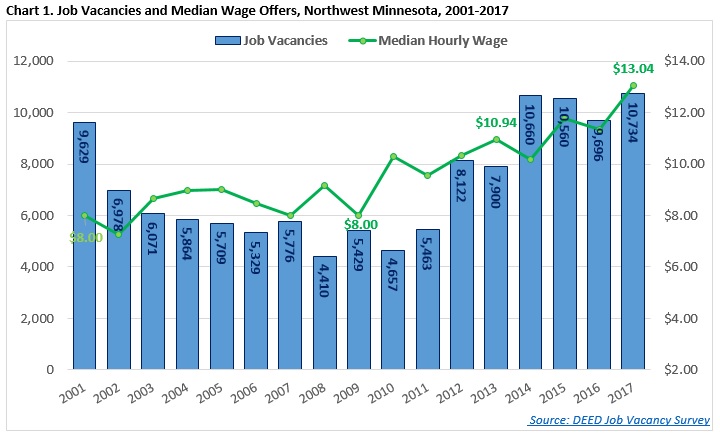 The presence of such industry powerhouses as Polaris, Arctic Cat and New Flyer make Northwest Minnesota a hub of transportation equipment manufacturing.
The presence of such industry powerhouses as Polaris, Arctic Cat and New Flyer make Northwest Minnesota a hub of transportation equipment manufacturing.
From wheat and potatoes to soybeans and sugar beets, the region is a major producer and processor of food staples and specialty agricultural products.
Want the freshest data delivered by email? Subscribe to our regional newsletters.
1/22/2018 12:04:56 PM
Chet Bodin
Workers are in high demand in Northwest Minnesota - and have been for a while. DEED's Job Vacancy Survey reported over 10,700 job openings in the second quarter of last year (Chart 1). This was the highest number recorded by DEED since the survey started in 2001. The consistent demand for workers is also leading to better wage offers in Northwest Minnesota, where the median offer was $13.04 per hour in the second quarter of 2017. Three years ago, when the total number of job vacancies in the region exceeded 10,000 for the first time, the median hourly wage offer was $10.18 - almost three dollars less. This is a remarkable change, when in comparison, it took from 2001 to 2013 for the median hourly wage in Northwest Minnesota to rise as much as it did from 2014 to 2017.

These trends suggest employers in Northwest Minnesota are starting to raise wage offers to attract more workers. But public and private organizations throughout the region are also exploring other ways to draw more residents and workers to their communities. Regional marketing efforts like Live Wide Open in West Central and The Good Life in Region Five are connecting cities and town in their respective areas to communicate their positive attributes broadly. In other instances, business leaders are approaching the workforce shortage independently.
For its part, DEED is working to connect some of these efforts and align public and private strategies throughout the state. Workforce Strategy Consultants in each region are convening leadership from multiple sectors to share knowledge and develop best practices. In addition, the University of Minnesota's Center for Community Vitality is researching how communities are both attracting and integrating newcomers.
The university's newcomer research builds on its landmark Brain Gain study, which countered traditional beliefs that rural areas of Minnesota were in decline. Using a simple cohort analysis, the study showed that oftentimes, workers in their prime are moving to rural Minnesota more than they're moving out. Chart 2 uses a similar analysis to show that this trend remains evident in Northwest Minnesota, at least for residents in their thirties and early forties.
The simplified cohort analysis works like this: Those in the 25- to 29-year-old age group in 2011 would have aged five years by 2016, and would then be in the 30- to 34-year-old age group in 2016. If no one died and no one moved in or moved out, the 25- to 29-year-old cohort would remain the same size over time, providing an 'expected' count of residents in their early thirties by 2016. However, the 'actual' numbers in these age groups in 2016 were higher, showing significant in-migration during the five-year period. In this simplified analysis, the Census Bureau's American Community Survey data show that an estimated 2,422 more people 30 to 44 years of age moved to Northwest Minnesota than moved out.

Armed with this knowledge, many communities are focusing on their strengths and developing programs with more emphasis on attracting adults in their thirties, many who bring experience and connections with them, not to mention families. So while retaining younger residents out of high school and college remains a priority, it's evident that newcomers to the region are generally older. This means that equal attention is being paid to qualities they look for, like public safety and access to childcare.
For regional employers, the work local communities and their regional partners are doing to advance their livability and appeal is a worthy cause. Ideally, they will find ways to address the record number of job vacancies in the region by welcoming new residents and making them feel at home.
Contact Chet Bodin.